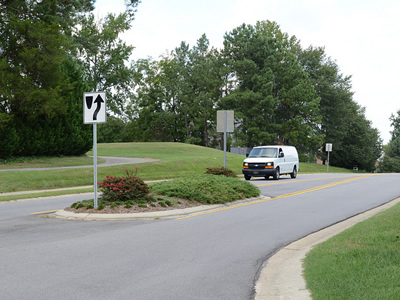A change could be coming to how the city deals with traffic calming in large mixed-use developments. The City Council will consider including traffic calming projects during the development process.
Today, the city doesn’t install traffic calming devices unless they are requested by the people in the neighborhood. Transportation staff study and rate the street so that it can be prioritized.
Each year, the City Council approves an updated list of streets scheduled for traffic calming and the money to fund nine to 12 of those projects.
As more urban developments are approved and begin construction, it is likely that the volume of traffic will increase.
 [/media-credit]
[/media-credit]Photo by City of Raleigh
A van drives thorugh an area with traffic calming mechanisms in place.
But as city Transportation Operations Manager Mike Kennon said, “Just because you have increased traffic volumes doesn’t mean you are going to have increased speeding.”
Figuring out what kind of traffic-speed impact a development could create for the surrounding neighborhoods is going to be a challenge and take up staff time, he said.
Kennon said that a change does have its pros:
• It would help the city to be more proactive rather than reactive.
• It would also keep the city from spending money that is already allocated to streets with existing problems rather than possible problems.
• If traffic calming projects are included within the scope of work for a development, neighbors might be more in favor of a project.
But the change comes with plenty of downsides that city staff members asked councilors to consider.
Developers would be responsible for designing, constructing and paying for traffic calming projects in neighborhoods that may never see an increase in speeding.
It also makes developers responsible for finding consensus between neighbors during what can sometimes be a very contentious discussion.
Residents who are opposed to a controversial development might see traffic calming as a way that developers are buying the approval of the neighborhood.
It is also unclear as to how the borders of these neighborhoods will be determined. A street two blocks away may be left out of the traffic calming plan, but still be affected by the development.
Councilor Thomas Crowder said while transportation staff can’t predict increases in speed, it is likely these developments will bring increased congestion.
Traffic and congestion along major streets and thoroughfares results in drivers cutting through neighborhoods to make up for lost time.
Crowder said he wants to know how will growth help pay for the increase in congestion associated with it.
Regardless, he said, more funding will be needed for the program.
What’s Next
Councilors will discuss the issue further in next week’s Budget and Economic Development Committee meeting.
